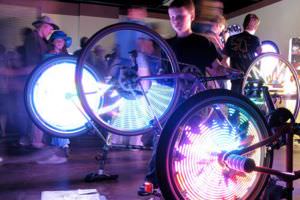In physics, power is the rate at which work is done and torque is the tendency of a force to rotate an object about an axis. While the unit of power is joules per second, the unit of torque is Newton meter.
Comparison chart
Power (physics)
In physics, power (symbol: P) is the rate at which work is performed or energy is transmitted, or the amount of energy required or expended for a given unit of time. As a rate of change of work done or the energy of a subsystem, power is:
 ,
,
where P is power, W is work and t is time.
The average power (often simply called "power" when the context makes it clear) is the average amount of work done or energy transferred per unit time. The instantaneous power is then the limiting value of the average power as the time interval Δt approaches zero.
When the rate of energy transfer or work is constant, all of this can be simplified to
 ,
,
where W and E are, respectively, the work done or energy transferred in time t (usually measured in seconds).
Torque
Torque is the tendency of a force to rotate an object about an axis. A torque can be thought of as a twist. It's magnitude depends on three quantities: First, the force applied; second, the length of the lever arm connecting the axis to the point of force application; and third, the angle between the two. In symbols:
where
 is the torque vector and
is the torque vector and  is the magnitude of the torque,
is the magnitude of the torque,
 is the lever arm vector (vector from the axis to the point of force application), and
is the lever arm vector (vector from the axis to the point of force application), and  is the length (or magnitude) of the lever arm vector,
is the length (or magnitude) of the lever arm vector,
 is the force vector, and
is the force vector, and  is the magnitude of the force,
is the magnitude of the force,
 denotes the cross product,
denotes the cross product,
 is the angle between the force vector and the lever arm vector.
is the angle between the force vector and the lever arm vector.
The length of the lever arm is particularly important; choosing this length appropriately lies behind the operation of levers, pulleys, gears, and most other simple machines involving a mechanical advantage.
Video explaining the differences
This video discusses the differences between torque and power:
Units of Power vs Unit of Torque
The units of power are units of energy divided by time. The SI unit of power is the watt (W), which is equal to one joule per second. Non-SI units of power include ergs per second (erg/s), horsepower (hp), metric horsepower (Pferdestärke (PS) or cheval vapeur (CV)), and foot-pounds per minute. One unit of horsepower is equivalent to 33,000 foot-pounds per minute, or the power required to lift 550 pounds one foot in one second, and is equivalent to about 746 watts. Other units include dBm, a logarithmic measure with 1 milliwatt as reference; (food) calories per hour (often referred to as kilocalories per hour); Btu per hour (Btu/h); and tons of refrigeration (12,000 Btu/h).
The SI unit for torque is the newton meter (N·m). In Imperial and U.S. customary units, it is measured in foot pounds (ft·lbf) (also known as 'pound feet') and for smaller measurement of torque: inch pounds (in·lbf) or even inch ounces (in·ozf).




 Energy
Energy  Force
Force  Difference Between Mass and Weight
Difference Between Mass and Weight Centrifugal Force
Centrifugal Force  Fusion
Fusion  Heat
Heat
Comments: Power vs Torque